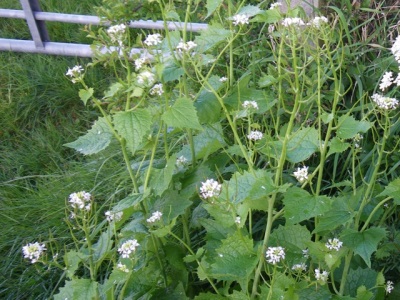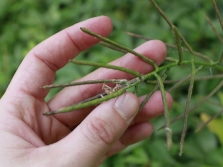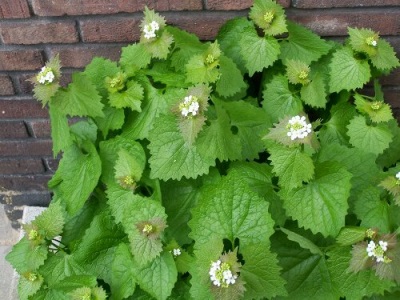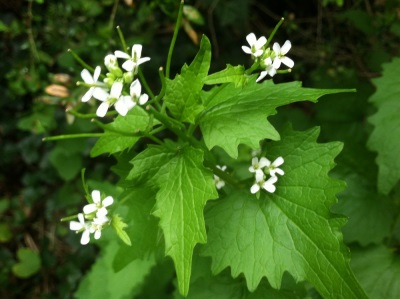Garlic grass (garlic)

Pedunculate garlic is a herbaceous plant with a slight smell of garlic and a burning taste of mustard. Belongs to the type of garlic cloves of the cabbage family.
Also found under the names:
- garlic grass;
- petiole garlic;
- medicinal garlic;
- garlic mustard;
- fox girchak.

Appearance
A biennial garlic herb plant looks like this:
- Height from 12 to 100 cm. The stems are solitary, have a bluish coating, pubescent at the bottom.
- Basal leaves have a triangular-reniform shape on long petioles. The edges are large rushed. The upper ones have a heart-shaped ovoid shape and sharp-toothed edges.
- Blooms in May. The flower petals are small and white. Sepals ovoid, pale green.
- The fruits are oblong quadrangular pods. Their length is 2-8 cm, and the diameter is about 2 mm. Ripen in June-July.
- When the pods open, you can see the seeds. Seeds are arranged in one row, longitudinally striated. The length is 3-4 mm.
- It has a pronounced garlic odor.

Where does it grow?
Garlic grass grows on fertile soil in gardens and vegetable gardens. Can be found among bushes in forests and parks.
Growing:
- In European countries, incl. and in the European part of Russia.
- in Central and Western Asia.
- In North Africa.
- Naturalized in the USA and Canada.

spice making method
Leaves and seeds are used as raw materials for the manufacture of spices. In May, i.e. during flowering, leaves are harvested, seeds in July, after they ripen.The characteristic aroma of garlic disappears after drying.



Characteristics
- It has a specific garlic aroma and a slightly pungent taste, which is why it was called the garlic herb.
- Garlic grass is a hostile plant. It is able to displace plants that accidentally fall into their growth zone.
- Capable of producing large quantities of seeds.
- In early spring, it becomes covered with foliage, thereby shading the fragile wildflowers.
- The chemical that this herb produces interferes with the growth of other plants.
- Petiolate garlic grass is similar to some wild flowers, especially Peter's Cross, another name for which is flake.

Nutritional value and calories
Calories per 100 g: 200 kcal.
The ratio of proteins, fats, carbohydrates: 20% | 21% | 0%
- Belkov: 14
- Fat: 15 g
- Carbs: 0.7 g

Chemical composition
In the chemical composition of garlic herb, many vitamins and various oils can be distinguished. Their composition depends on the part of the herb.
Leaves
The leaves contain:
- Glycoside sinigrin or sinigrin hydrolysis. By releasing allyl mustard oil, it gives this plant the aroma of garlic.
- Flavonoids (Alliarosil). It has a powerful antioxidant effect. Promotes healing and rejuvenation of the body.
- Vitamin C. It also has antioxidant properties.
- Carotene. One of the many properties of which is the improvement of lung function.

The pistils and anthers contain a huge amount of flavonoids.
seeds
Found in plant seeds about 30% fatty oils.
The seeds contain acids such as:
- erunic;
- linoleic;
- oleic;
- linolenic;
- palmitic;
- eicosenoic acid, etc.;
- 0.5–1% mustard oil;
- as well as thioglycoside sinigrin.
The roots are also rich in the thioglycoside sinigrin.



Beneficial features
Thanks to the material composition described above, garlic cloves are:
- anthelmintic (antihelminthic);
- expectorant;
- antiscorbutic;
- diuretic and diaphoretic;
- antiseptic;
- anti-asthma agent.

Contraindications
Caution should be exercised when using garlic internally, as large doses can be poisonous.
This is especially true for people who have the following diseases:
- kidney inflammation;
- inflammation of the liver;
- diseases of the gastrointestinal tract.
They are advised not to use grass.
Application
In cooking
Garlic grass as a vegetable has been known since the 17th century. She was especially popular in cooking with the British.

Leaves and stems are added to dishes in spring, and roots in autumn.
Here is a short list of options for eating it:
- Leaves and trunks (stems). You can eat while they are still soft, ie. before flowering. After that, the trunks become stiff, so only the leaves can be eaten. Here the plants are used as spices (instead of garlic). Leaves can be added: to sandwiches and sandwiches with various oils and meats, salads, vegetable dishes (such as stews), sauces, soups.
- Roots. The taste and smell of the roots resemble horseradish. Added in the form of spices to snacks and salads, seasoned with vinegar and oil. It should be borne in mind that garlic cloves are dangerous in large quantities. The inhabitants of the Caucasus cook amazing cabbage soup and make salads from the roots.
- Seeds. They make fatty oil.
With vitamin deficiency in early spring, it is very useful to make salads and soups from the leaves of the plant. Check out some of their recipes.



beetroot salad
Required Ingredients: 50 grams of garlic leaves; beets 2-3 pieces; hard apples 2 pcs.; horseradish 2 sheets; a few tablespoons of mayonnaise; a pinch of salt.
Cooking:
- Finely chop the garlic and horseradish leaves.
- Wash and clean the beets.
- Wash and remove the core of the apples.
- Grate the beets and apples.
- Mix everything.
- Salt to taste and season with mayonnaise.

Salad with herbs, cucumbers and sour cream
- Rinse thoroughly 100 grams of garlic leaves and 10 grams of parsley, dill and green onions.
- Gently dry and chop the leaves with herbs.
- Slice 2 cucumbers and 2 tomatoes.
- Mix everything chopped, salt and season with sour cream.
- Sprinkle 3-4 tablespoons of chopped walnuts on top.
- At the discretion, decorate the salad with sprigs of greens.
- Place in refrigerator for 30 minutes.
In order to make this salad more satisfying, you can add boiled potatoes to it.
In medicine
Despite the fact that modern medicine does not use garlic, it is widely known in folk medicine. Externally used for rinsing from sore throats and diseases of the oral cavity.
Before use, we advise you to consult a doctor, since an overdose threatens with poisoning.

Crushed seeds are often used as mustard plasters.
They help in the treatment of:
- boils and burns;
- bronchial asthma;
- scurvy;
- diarrhea;
- worms;
- and even gout and neuralgia.
Leaves and an aqueous infusion of leaves in a mushy form or applications are used in the treatment of:
- cuts and wounds of various types;
- abscesses;
- ulcers;
- gangrene;
- fungus.

Healing infusion
Pour 1 teaspoon of leaves into a bowl. The leaves must be dry and crushed. Pour 1 cup boiling water on top, leave to infuse for 10-15 minutes. Cool down. Strain. It is recommended to take no more than 4 times a day, 1 tablespoon.
Treatment of worms
To do this, you need: take 2 tablespoons of leaves, pour one and a half glasses of boiling water in a thermos. Steep for 1 hour, then strain. The broth is ready, take 4-5 times 50 ml.
For the treatment of fungus on the legs
It is necessary to crush the leaves of garlic. Dissolve 1 teaspoon of salt in one liter of clean water. Mix 1 tablespoon. a spoonful of crushed leaves with this water. Insist for 10-15 minutes. Strain the decoction. Take a terry cloth or cotton wool, soak in a decoction. Apply to the area affected by the fungus for 4-5 hours.
Infusion in the treatment of abscesses and hard-healing purulent wounds
For 250 ml of boiled water, take 2 tablespoons of leaves. The leaves must first be dried and crushed. Instead of leaves, you can take 2 teaspoons of garlic grass seeds. Insist 1 hour in a warm place. Strain the infusion and wash the wounds with it.
cultivation
It is necessary to sow garlic in late October and early November. For this, it is better to choose fertile and humus-rich soils. Garlic grass can grow in full sun, but grows best in shade. Well bred by self-seeding. Sprouts appear at the end of April, and blooms from May to June for 30-40 days. Fruit ripens in July.

Interesting Facts
It is known that as a spice in salads, garlic grass was used in Europe as early as the Neolithic period, and was later replaced by other products.
Animals love to eat this plant. If a cow eats garlic cloves, her milk turns orange and acquires a garlic flavor.



















I make a salad with garlic, like here with beets. By the way, the taste does not seem that the salad is grass-grass :D